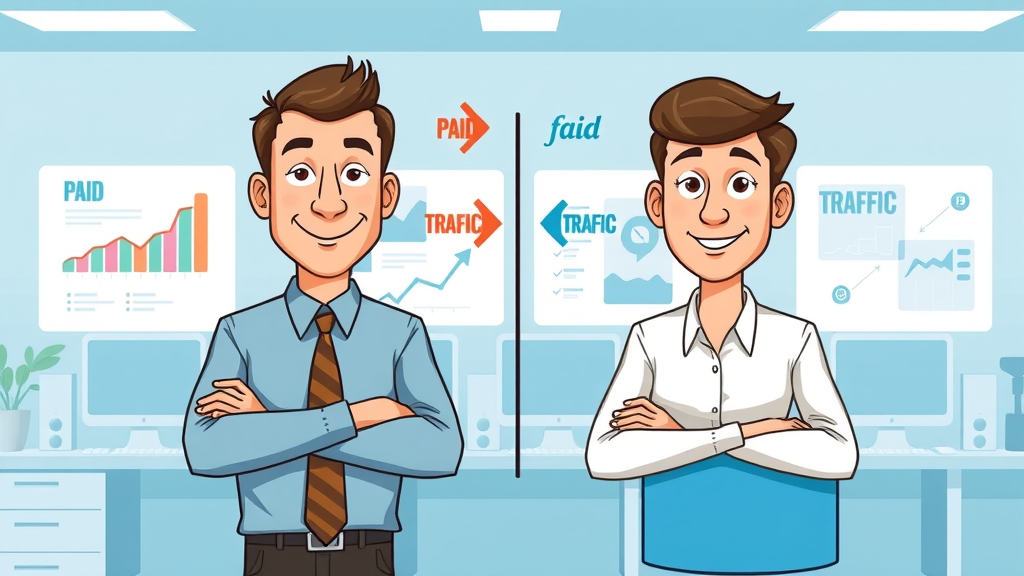- Did you know that over 81% of brands use affiliate marketing to drive sales and traffic, making ‘affiliate traffic and promotion’ one of the fastest-growing revenue streams online? In this comprehensive guide, learn how to master affiliate traffic and promotion to increase your sales exponentially.

Unlocking Affiliate Traffic and Promotion: A Roadmap for Swift Sales
- Discover what affiliate traffic and promotion involve, why it matters for all affiliate marketers, and see immediate examples where affiliate marketing delivers measurable business growth.
Affiliate traffic and promotion represent the twin engines of rapid online growth for brands and aspiring marketers. Whether you’re a seasoned affiliate marketer or just starting out, understanding the intricacies of traffic sources —from free traffic via SEO to paid traffic such as Google Ads—can supercharge your promotional efforts. For instance, a single well-placed affiliate link in a high-traffic blog post can turn thousands of readers into leads overnight, while targeted social media campaigns can enlist new customers with viral velocity.
The landscape of affiliate marketing is fast-paced and competitive. Those who harness multiple affiliate marketing traffic sources —while optimizing every affiliate link —consistently pull ahead of the pack. Across industries, businesses leveraging smart affiliate traffic and promotion strategies are landing higher conversion rates and scaling sales rapidly. In the following sections, you’ll find actionable tactics, real-world examples, and detailed steps to drive traffic and transform your promotion strategies for lasting affiliate marketing success.
What You'll Learn: Key Tactics for Affiliate Traffic and Promotion Success
- The importance of affiliate links and how to use them to maximize earnings
- Identifying high-impact traffic sources and marketing traffic strategies
- Increasing conversion rates with proven affiliate program techniques
- Distinguishing free vs. paid traffic for smart promotion decisions
In this guide, you’ll unravel the secrets behind affiliate traffic and promotion that top affiliates use daily to dominate search engine results and social feeds. You’ll understand how to blend organic traffic with paid promotions using strategic affiliate offers and optimized landing pages. We’ll cover what separates high-performing affiliate marketing campaigns from the rest—including compliance, transparent disclosures, and the right way to structure your email marketing , so every click counts. By focusing on both free and paid traffic sources , your reach and revenue will never stagnate.
Understanding Affiliate Traffic and Promotion Essentials

What is Affiliate Traffic? (People Also Ask)
- Affiliate traffic refers to the visitors guided to a business or merchant’s website through affiliate links placed by partners or affiliate marketers as part of an affiliate marketing program.
Affiliate traffic is the foundation of affiliate marketing success. It's the flow of potential customers to an offer, product, or service through strategically positioned affiliate links —whether in a blog post , on social media, or within an email list. This form of traffic is unique because it’s driven by trusted partners who use their platforms and influence to recommend relevant affiliate products to their audiences. When visitors click these affiliate links, they’re tracked, and any resulting sales or actions generate a commission for the affiliate marketer. This symbiotic system fuels a constant loop of content creation and performance-driven traffic.
Unlike traditional ads, affiliate traffic usually comes with built-in credibility and targeted intent, resulting in higher conversion rates. Whether guides, tutorials, or solution-based blog posts , if you structure your affiliate promotion around your target audience’s problems, you naturally attract engaged, high-value traffic. Over time, optimizing and diversifying your traffic sources ensures you’re not dependent on a single platform or strategy, guarding your affiliate income against ever-shifting online trends.
What is an Affiliate Promotion? (People Also Ask)
- An affiliate promotion is a marketing campaign or activity where an affiliate marketer shares an affiliate link to an offer, product, or service—generating traffic and potential sales in exchange for commission.
An affiliate promotion is any strategic effort by an affiliate marketer to amplify exposure to an offer, drive relevant traffic, and ultimately convert visitors into paying customers. This involves sharing affiliate links across a suite of marketing channels such as blog posts, Facebook ads, or email marketing series. The goal of every affiliate promotion is to position affiliate offers in front of a target audience most likely to take action, whether that’s purchasing a product, signing up for a service, or downloading an app.
Effective affiliate promotions require a deep understanding of your audience’s needs and online behavior. It’s not just about "dropping links"—it’s about crafting persuasive, value-rich campaigns that solve real problems and establish you as a trusted source of recommendations. The best affiliate promotions use data, creativity, and a blend of both free and paid marketing traffic sources to make your marketing efforts stand out.
Affiliate Traffic and Promotion: The Difference Between Paid and Free Traffic
- Explore how affiliate marketers leverage both paid and free traffic sources, including organic traffic, social media outreach, and search engines, to amplify affiliate marketing traffic and program results.
Navigating the difference between paid traffic and free traffic is crucial for affiliate marketers aiming to maximize profits. Free traffic (or organic traffic) comes from unpaid sources—like blog posts ranked in search engines, social media shares, or community forums. It’s cost-effective and sustainable, providing ongoing exposure long after the initial marketing effort. On the flip side, paid traffic involves investing in targeted ads (Google Ads, Facebook Ads, or native advertising) to instantly drive traffic to a landing page or affiliate offer.
Each traffic source has its place in a robust affiliate marketing strategy. Free traffic builds authority and long-term gains, perfect for those willing to invest time in content and SEO. Paid marketing traffic accelerates results, allowing you to scale promotions rapidly and test affiliate marketing traffic sources with precision. By blending both, you achieve a balanced, resilient promotional strategy that doesn’t rely solely on one type of audience or algorithm.
| Aspect | Paid Traffic | Free Traffic |
|---|---|---|
| Examples | Google Ads, Facebook Ads, Native Ads | SEO, Blog Posts, Social Media, Forums |
| Cost | Requires ongoing ad spend | Low to none (time investment) |
| Speed of Results | Immediate visibility | Slower build, compounding over time |
| Sustainability | Stops when ad spend stops | Lasts months or years with upkeep |
| Scalability | Easily scalable with budget | Scalable with content and reach |
The Pillars: Affiliate Link Strategy and Optimizing Affiliate Links
Maximizing Clicks with Optimized Affiliate Links
- Best practices for inserting affiliate links in blog posts, social media, and email marketing, improving click-through and conversion rates across all affiliate offers.

The core of every thriving affiliate marketing campaign lies in strategic affiliate link placement and optimization. Whether you’re drafting a blog post or curating your email marketing sequence, where and how you use your affiliate links directly impacts your conversion rate. Place links contextually within valuable content—think product reviews, comparison guides, or step-by-step tutorials—to ensure readers perceive them as helpful, not intrusive. Use clear anchor text and call-to-actions that encourage clicks (“Try it now,” “See today’s deal,” etc.).
Don’t limit your efforts to just blog posts. Incorporate affiliate links in resource pages, social media posts, and even within podcast descriptions or YouTube video notes. Use link cloaking and tracking tools to make URLs clean and monitor which placements convert best. Test link positions (top, middle, or end of content) and formats (buttons vs. text links) to see where your audience is most likely to engage, driving optimal marketing results.
Compliance and Transparency in Affiliate Programs
- How to legally promote affiliate offers, follow affiliate program guidelines, and build trust through clear affiliate link disclosure.
In the era of transparency, adhering to affiliate program policies and legal requirements is non-negotiable. Always include a clear affiliate disclosure near your affiliate links, letting your readers know you may earn a commission if they purchase through your recommendation. This builds trust and keeps you compliant with FTC and program-specific guidelines. It also demonstrates your honesty as an affiliate marketer, making your audience more likely to engage with future promotions.
Regularly review the terms and conditions of every affiliate program you join, as rules around link placement, email promotions, or paid traffic campaigns can differ widely. Being proactive with transparency and compliance not only protects your income but also fosters long-term relationships with both your audience and partner brands.
Driving Traffic: Essential Affiliate Marketing Traffic Sources
Top Free Traffic Sources for Affiliate Marketing
- Harness the power of high-authority blog posts, guest blogging, SEO with search engine optimization strategies, and vibrant social media communities for sustainable, organic traffic.

Leveraging free traffic sources is often the smartest long-term strategy for affiliate marketers. High-quality blog posts and guest contributions on relevant sites can generate recurring organic traffic from search engines . Bolster your content with SEO best practices: keyword research targeting your affiliate offers, internal linking, and authority-building backlinks. Posting regularly in active social media communities (like Facebook groups or Twitter threads) allows you to connect with targeted audiences and scale reach for zero cost.
Don’t underestimate the power of community forums, Q&A platforms, or niche content nodes like Reddit, Quora, or Pinterest. Authentic engagement and helpful answers peppered with appropriate affiliate links can steadily funnel potential customers to your offers. As your library of blog posts and content grows, so too does your stream of organic traffic , providing a passive foundation that delivers results month after month.
Leveraging Social Media Platforms for Affiliate Traffic and Promotion
- Facebook, Instagram, Twitter, TikTok, and Pinterest: Learn tailored strategies for each platform to increase affiliate traffic and optimize affiliate promotions.
Each social media channel offers unique features and audiences for affiliate traffic and promotion . On Facebook, targeted groups and pages devoted to specific interests yield high-intent engagement. Instagram’s visual storytelling is perfect for product spotlights and swipe-up affiliate links in stories. Twitter enables real-time conversations and rapid sharing of affiliate offers via threads and trending hashtags.
TikTok stands out for virality; strategic calls-to-action and bio links on trending videos can drive thousands to your landing page in hours. Pinterest, the visual search engine, rewards consistent pinning of compelling images that link back to SEO-optimized blog posts or affiliate product pages. By understanding the culture and best practices of each platform—and tracking which traffic sources convert best—you can continually refine your social media strategy and grow your affiliate income at scale.
Harnessing Email Marketing for Affiliate Promotion
- How email marketing sequences, newsletters, and exclusive offers can be structured with affiliate links for maximum impact.

Building and nurturing an email list remains one of the most effective methods for affiliate promotion. With a loyal subscriber base, you can launch tailored email marketing campaigns highlighting exclusive affiliate offers, product launches, and helpful resources. Segmenting your list allows you to deliver relevant content to different audience groups, increasing the chances they’ll click your affiliate links .
Try multi-step email sequences: introduce the offer, provide educational value in a follow-up, and close with a persuasive call to action. Test different subject lines, email designs, and timing to maximize open and click-through rates. Never forget to include disclaimers about affiliate content for compliance—and always focus on delivering value first, sales second.
Scaling Up: Paid Traffic Sources and Advanced Affiliate Traffic Techniques
Using Paid Traffic: Google Ads, Facebook Ads, and Native Ads for Affiliate Marketing
- Analyze paid options for affiliate traffic—pros, cons, and optimization strategies for driving commission-generating traffic with specific marketing traffic sources.

For affiliates ready to accelerate growth, paid traffic sources like Google Ads , Facebook Ads, and native ad networks offer unmatched speed and scale. Google Ads excel at capturing search intent—target keywords related to your affiliate offer for high-conversion clicks. Facebook Ads deliver robust audience targeting based on demographics, behavior, and interests, making it ideal for segmenting your marketing efforts and reaching those most likely to engage.
Native ads blend seamlessly into content feeds (think Outbrain or Taboola), pushing affiliate offers to broad new audiences with minimal disruption. The key to success is rigorous split-testing: headlines, images, and calls to action must be data-driven. Always monitor ROI, as costs can rise quickly; begin with a modest spend, then increase budgets on proven winners to scale affiliate revenue efficiently.
Retargeting and Lookalike Audiences for Affiliate Offers
- Boost your conversion rate through retargeting campaigns and leveraging lookalike audiences in paid platforms.

Retargeting and lookalike audience strategies multiply the ROI of your paid affiliate traffic campaigns. Retargeting allows you to show targeted ads to users who’ve visited your blog posts or clicked your affiliate links but have not purchased yet—reminding them of the value and nudging them to take action. These campaigns consistently raise overall conversion rates, as they focus on the most engaged subsets of your audience.
Lookalike audiences let you reach thousands of new potential customers with similar profiles to your best existing buyers. Platforms like Facebook Ads and Google Ads use sophisticated data to identify users most likely to convert, extending your marketing traffic reach while maintaining high intent. By incorporating these tools into your paid promotion, you lower customer acquisition costs and unlock new pockets of affiliate revenue.
| Traffic Source | Click-Through Rate (CTR) | Conversion Rate | Cost Per Acquisition (CPA) |
|---|---|---|---|
| Google Ads | 2–7% | 2–5% | $10–$50 |
| SEO (Organic Blog Posts) | 1–3% | 3–8% | $0 (Time Investment) |
| Facebook Ads | 1–5% | 2–5% | $10–$40 |
| Email Marketing | 10–30% | 5–20% | $0–$5 (List Building Costs) |
Content Marketing: The Power of Blog Posts and Search Engine Traffic
Creating SEO-Optimized Blog Posts for Affiliate Links
- Step-by-step writing formula for blog posts that blend valuable content, affiliate marketing expertise, and strategic affiliate links.

To dominate search engine results and attract organic traffic , every affiliate marketer should master crafting high-authority blog posts . Your formula should begin with in-depth keyword research—discover phrases your audience is searching and align them with your affiliate offers. Structure your blog post with compelling headlines, value-packed subheadings, and solution-driven content that educates and entertains.
Seamlessly integrate affiliate links into the post, using contextually relevant anchor text that invites the reader to learn more or try the product. Optimize images with descriptive alt-text and utilize internal links to guide visitors through your content ecosystem. Regularly update your blog posts to maintain freshness and authority in the eyes of search engines, and always include a call to action that prompts readers to engage.
Using Search Engines & Organic Traffic for Sustainable Growth
- Keyword research, on-page SEO, and link-building methods that attract organic traffic and build a long-term affiliate marketing traffic foundation.

Achieving consistent organic traffic hinges on mastering both on-page and off-page SEO techniques. Start with keyword research using tools like Ahrefs or SEMrush; target a mix of high-volume and long-tail keywords tied to your affiliate products. On each page, optimize titles, meta descriptions, and headings for clarity and relevance. Incorporate internal links to bolster site structure and external authority backlinks to boost rankings.
Content isn’t king unless it’s discoverable—so build relationships for guest posting, participate in industry forums, and always share your best content where your target audience gathers. Over time, these methods create a self-sustaining engine of search engine-driven traffic, reducing reliance on risky or expensive paid traffic campaigns.
Conversion Mastery: Optimizing Affiliate Offers and Landing Pages
Proven Methods to Increase Conversion Rates with Affiliate Programs
- Actionable tactics to optimize landing pages, align affiliate offers with audience intent, and elevate conversion rates for all affiliate traffic and promotion campaigns.

Maximizing your conversion rate means going beyond clicks—your landing page must speak directly to your audience’s pain points and desires. Test multiple layouts, headlines, and calls to action to determine what resonates best. Keep your messaging clear and benefits-focused, and always align the affiliate offer with the original promise made in your marketing traffic source (such as an ad or blog post). Use social proof, testimonials, and comparison charts to reduce hesitation and encourage action.
Mobile responsiveness can make or break your affiliate conversion rates. Ensure every landing page is fast, user-friendly, and easy to navigate on smartphones and tablets. Incorporate urgency elements (like limited-time offers) and minimize distractions to keep the visitor focused on the conversion goal.
Testing, Tracking, and Analytics in Affiliate Marketing
- Implement A/B tests, monitor traffic source performance, and refine affiliate promotion efforts using data-driven insights.
Testing and analytics are the unsung heroes of high-performing affiliate marketers. Conduct regular A/B testing on all marketing assets—from ad creatives to landing pages and email subject lines. Use analytics platforms (Google Analytics, affiliate dashboards) to track which traffic sources fuel the most conversions, then invest more resources into those winners. Periodically review your data to spot trends, optimize underperforming elements, and trim any weak links in your marketing chain.
"The best affiliate marketers are relentless testers, using data to inch ever closer toward perfect conversions."
Data-driven optimization transforms static promotions into thriving, evolving campaigns. Never settle for "good enough"—improvement is continuous, and small tweaks can mean big gains in your overall affiliate income.
Scaling Smart with Multiple Affiliate Programs and Traffic Sources
- Smart multi-program management—diversifying affiliate links across several traffic sources to reduce risk and maximize opportunity.
The top affiliates never place every egg in one basket. By working with multiple affiliate programs and spreading promotions across various traffic sources , you protect your income from sudden changes—like a search engine algorithm update or a single program discontinuing. Track and compare performance across all channels, using a central dashboard or spreadsheet to identify top earners and emerging opportunities.
Diversification doesn’t just minimize risk—it also multiplies your potential reach. New affiliate products and programs can be introduced to specific audience segments, ensuring your marketing efforts stay fresh and aligned with changing trends. Strategic cross-promotion between email lists, blog posts, and social campaigns builds synergy and unlocks new avenues of sustainable growth.
Expert Insights: Affiliate Traffic and Promotion Success Stories
"Switching to a diversified traffic source model tripled my affiliate income in under 90 days." — Established Affiliate Marketer
Behind every headline success, there’s a commitment to data, experimentation, and an openness to change. Affiliate marketers who evolve—experimenting with new content formats, partnerships, and marketing traffic sources—inevitably discover new pockets of revenue. Whether you focus on SEO, social, or paid traffic, the most profitable affiliates stay curious and proactive, learning from both wins and setbacks.
Learning from real-world case studies and expert quotes arms you with the mindset and tactics required to sustain rapid sales growth, no matter how the affiliate marketing landscape shifts.
Frequently Asked Questions About Affiliate Traffic and Promotion
Can you make $100 a day with affiliate marketing? (People Also Ask)
- Yes, many affiliate marketers earn $100 a day or more by choosing high-performing affiliate programs, optimizing affiliate links, and combining quality traffic sources and targeted promotion.
Absolutely. Once you identify affiliate offers with strong commissions and match them with the right audience through optimized blog posts, paid ads, and email marketing, it’s very possible to reach (and exceed) $100/day. Consistency, smart traffic management, and relentless optimization are the keys.
Do affiliate links count as paid promotion? (People Also Ask)
- Affiliate links themselves are not paid promotions, but if you use paid advertising (like Facebook or Google Ads) to promote affiliate links, it often must be disclosed as paid promotion.
Affiliate links by themselves do not constitute a paid promotion. However, if you buy ad space (like a Facebook ad or Google Ads) to showcase those links, you’re engaging in paid promotion—and you must disclose it according to platform and legal guidelines.
What is an affiliate promotion?
An affiliate promotion is a campaign or marketing action (like a blog post, email blast, or paid ad) designed to spotlight an affiliate offer, funnel traffic to it, and generate sales or signups for commission.
What is affiliate traffic?
Affiliate traffic is all the visitors sent to a merchant or affiliate program via an affiliate link, whether from a website, email, social platform, or ad. This is tracked for commission payouts.
Quick Action Plan: Steps to Improve Affiliate Traffic and Promotion Today
- Evaluate current affiliate links and diversify traffic sources
- Optimize blog posts and landing pages for conversion
- Split-test paid and free traffic strategies
- Reinforce transparency and compliance in all affiliate programs
- Monitor analytics and tweak for continually improved results
Key Points Every Affiliate Marketer Needs to Remember
- Set realistic traffic and revenue goals
- Don’t rely on a single traffic source
- Prioritize both organic and paid marketing traffic channels
- Always track, test, and refine affiliate promotion techniques

Take the Next Step: Supercharge Your Affiliate Traffic and Promotion Results
- Apply the affiliate traffic and promotion strategies covered to boost sales, expand reach, and secure your place as a successful affiliate marketer.
To enhance your understanding of affiliate traffic and promotion, consider exploring the following resources:
-
“10 Proven Strategies to Increase Traffic for Your Affiliate Program” : This article outlines effective methods such as optimizing your website for SEO, leveraging social media marketing, and producing high-quality content to drive targeted traffic to your affiliate offers. ( linksaffiliate.com )
-
“6 Proven Strategies to Skyrocket Your Affiliate Marketing Traffic” : This piece delves into tactics like leveraging social media platforms, engaging in content marketing, and collaborating with influencers to boost your affiliate marketing traffic. ( zeroparallel.com )
By implementing the strategies discussed in these resources, you can effectively increase traffic to your affiliate offers and maximize your earning potential.
 Add Row
Add Row  Add
Add 




Write A Comment